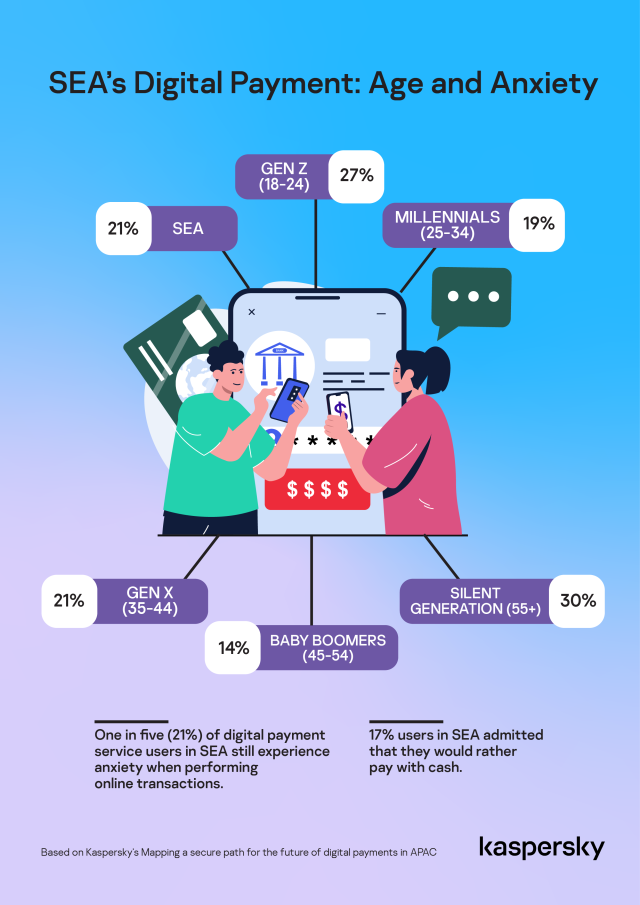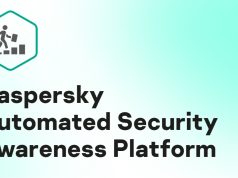Study reveals senior citizens’ worries about online transactions and their trust in antivirus software compared with the younger generation
05 May 2022
Digital payment has emerged to be the leading choice for many consumers in Southeast Asia (SEA) when it comes to conducting their online financial transactions. A recent Kaspersky research showed that digital considerations about cybersecurity and payments factor heavily into a consumer’s purchasing behavior in the region.
Titled “Mapping a secure path for the future of digital payments in APAC”, the study discovered that one in five (21%) of digital payment service users in SEA still experience anxiety when performing online transactions. Among other ages, worry is highest with the oldest group, the Silent Generation (30%). Interestingly, the “seniors” are followed by the youngest generation at 27%.
Almost one in five (17%) users in SEA admitted that they would rather pay with cash, wherein the oldest generation again logged the highest percent (20%) among all the age groups.
Adapting to these new technologies can also present a challenge to the Silent Generation with 20% of them noting difficulties on doing financial transactions online.
On the brighter side, nearly a quarter (24%) of all respondents from Southeast Asia indicated that they fully trust digital payments.

“The older adults are not from the internet age. Their worries are understandable and should be seen as a precautionary measure towards making a costly mistakes in a technology they are still learning to use. It is, however, noteworthy that most of them (26%) do trust digital payment platforms. As they are welcome to adopting to changes, we encourage the younger generation to step forward and assist our older loved ones. Community and government awareness and education efforts are also essential,” says Sandra Lee, Managing Director for Asia Pacific at Kaspersky.
Given their preference to being careful online, it is not surprising that the oldest generation favors the efficiency of antivirus software the most. More than three in five (61%) of adults aged 55 and above showed the highest level of trust towards security solutions compared with the younger age groups.
While on the average, half of all generations in SEA (50%) understood the need for antivirus software to protect their money and online data, Gen Z showed the least trust at 46%, Millennials at 49%, and Gen X at 52%.
Almost a quarter (20%) of all respondents felt that the use of antivirus software was sufficient, followed by 17% where respondents were uncertain or unaware about how antivirus could help them mitigate the risk of financial loss.
Alarmingly, there is still some 14% who said that antivirus software was not an essential tool in the fight against cyber threats seeking to compromise financial data and property.
“The true significance of security solutions should be best understood at present time when we hear about scams and financial frauds, one after another. Cybercriminals understand our habits and emotional states, as they are humans, too. We have seen how they are becoming more and more creative in targeting us with their social engineering attacks so we urge all generations to look into safeguarding their devices with the right tools to secure not only their data but most importantly their hard-earned money,” adds Lee.
To help the older adults embrace technologies securely while they are online, Kaspersky experts suggest the following:
- Installing, launching, updating and effectively using devices and apps is an issue for some older users. Parental controlsare not just for restricting children activities – they can also be used to simplify things for the older adults. Controlled user accounts can help manage their computers, devices, and apps by restricting the number of options they have access to so they avoid confusion and inadvertently launching programs. It can also allow remote logins to help manage activities.
- Make sure their apps and programs are set to update automatically so they always have the latest and most secure versions.
- Security solutions and practical steps can minimise the risk of falling victim to threats and keeping financial information safe. Utilise reliable security solutions for comprehensive protection from a wide range of threats, such as Kaspersky Internet Security, Kaspersky Fraud Prevention and the use of Kaspersky Safe Money to help check the authenticity of websites of banks, payment systems and online stores you visit, as well as establish a secure connection.
- Regularly explain them the essentials of safe internet and cyber hygiene practices. Teach them on how to keep their password privately, only share information with person they know in real life, only connect to home network when making online transaction, and never click on doubtful links, etc.
- Encourage them to contact you if they have any questions or require assistance in the digital world.
Users can also opt for the latest offers from the global cybersecurity company here:
- https://www.lazada.sg/shop/kaspersky/
- https://shopee.com.my/kaspersky
- https://www.kasperskyph.com/
- https://kaspersky.proguide.vn/
- kasoshopping.com
- https://www.tokopedia.com/kaspersky-id
To read the full report, please visit https://kas.pr/b6w8.
Survey Methodology
The Kaspersky “Mapping a digitally secure path for the future of payments in APAC” report studies our interactions with online payments. It also examines our attitudes towards them, which hold the key to understanding the factors that will further drive or stem the adoption of this technology. The study was conducted by research agency YouGov in key territories in APAC, including Australia, China, India, Indonesia, Malaysia, Philippines, Singapore, South Korea, Thailand and Vietnam (10 countries). Survey responses were gathered in July 2021 with a total of 1,618 respondents surveyed across the stated countries.
The respondents ranged from 18-65 years of age, all of which are working professionals who are digital payment users.
Through this study, when the behavior of the population of a market is generalised, it is in reference to the group of respondents sampled above.













